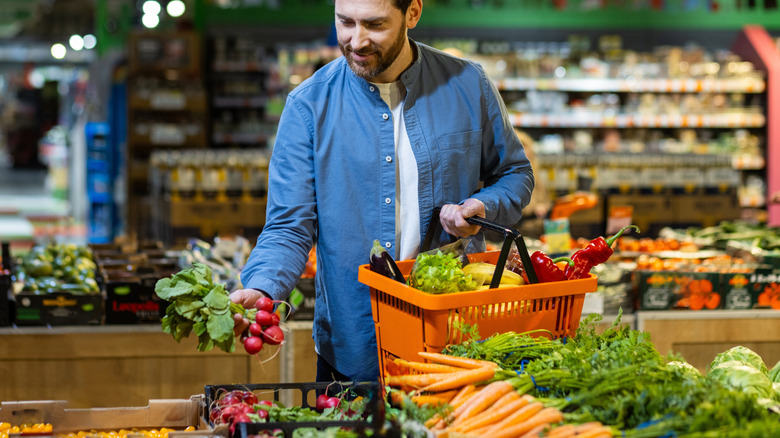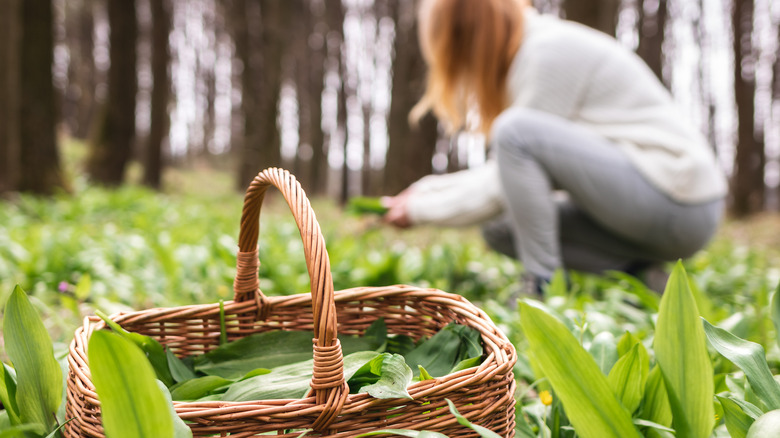An Underrated Vegetable That's Low In Calories Can Prevent Heart Disease And Blood Clots
In the middle of the spring, an underrated plant that grows in the forests of various parts of the United States becomes the central attraction of foragers and foodies. People go bananas for this aromatic vegetable — called a ramp or wild leek — mainly because it's seasonal, takes a long time to mature, and is notoriously hard to find.
Ramps usually aren't a cultivated crop; instead, they grow in the woods. Since they need years to develop, they require a sustainable touch from harvesters. Accordingly, responsible ramp lovers will only snag a few leaves during a foraging journey and leave the bulb and plant intact so it can produce for many seasons to come.
Like leeks, garlic, and onions, ramps are part of the allium family. Ramps share the common allium pungent taste and odor, which is part of a defensive chemical process that happens when alliums are cut or crushed. They also share alliums' reputation for giving much-needed TLC to your heart and vascular system.
Allium veggies have been well-documented for their cardioprotective capabilities, which is a good reason to pull on your hikers and go ramp hunting. For example, a 2017 study in Food Technology and Biotechnology showed that all allium plants helped prevent blood from clotting. (Blood clots can lead to stroke and death.)
Strong smell plus strong taste equals stronger heart
A 2014 study in the Potravinarstvo Scientific Journal for Food Industry noted that three major alliums — leeks, garlic, and onions — offered cardio-preventative advantages due to their high levels of antioxidants. After testing each allium's concentration of antioxidant compounds, leeks bested garlic, but not onions. (Read why eating onions has an unexpected effect on your cholesterol.)
Leeks also had a high concentration of kaempferol, a flavonoid capable of reducing inflammation. According to a 2020 article in Molecules, kaempferol may lower oxidative stress in the body. In turn, this can decrease the risk of atherosclerosis, or hardening of the arteries, as happened in two studies that were conducted on animal subjects. (Try these foods that can help prevent clogged arteries.) The article also cited a study on the effect of eating kaempferol-containing foods on humans. In that study, participants experienced drops in inflammatory biomarkers after just two weeks of being on a kaempferol-heavy diet.
A seasonal treat for your inner foodie
All this is great news if you're into incorporating new veggies into your meal rotations. Just be aware that ramps are only available for a few weeks a year and are hard to find, even if you're a foraging pro. Fortunately, you can always order ramps online, but you'll pay a premium.
Ramps are a delicacy that some states consider "threatened" or even "endangered" due to over-harvesting, hence their heftier price tag. As of spring 2025, one pound of freshly (and ethically) harvested ramp leaves sold for around $30 online. Consequently, combing the woods for ramps could be more economical than buying them outright — and you'd also get in the perfect number of steps you should walk every day as an extra benefit for your efforts.
Regardless of how many ramps you order or forage this year, be sure to use them quickly. Ramps may be flavorful and intense when first picked, but they turn bad after a few days. Therefore, either eat your ramps right away in raw or cooked form (ramp leaves are easily interchanged for leafy greens like kale or spinach). Alternatively, blend them into pesto or dry them to add to a homemade seasoning mix. And if you find yourself visiting Appalachia in the springtime, be on the lookout for ramp dinners. These feasts pop up after the winter thaw and offer a taste of the region's beloved forest plants.



